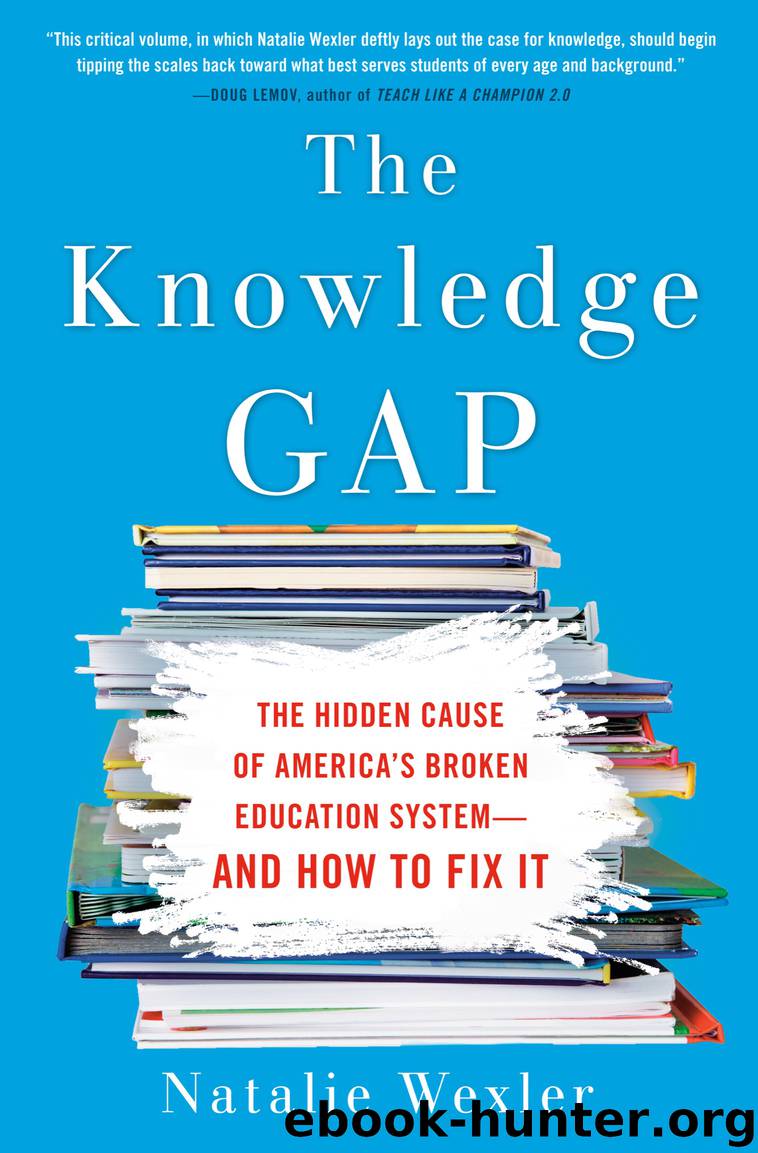The Knowledge Gap by Natalie Wexler

Author:Natalie Wexler
Language: eng
Format: epub
Publisher: Penguin Publishing Group
Published: 2019-08-05T16:00:00+00:00
* * *
—
IN JULY 2009—while the Common Core was still embryonic and had not been publicly released—the first rumblings of criticism emerged. It came from an unexpected source: the Core Knowledge Foundation, founded by a man Coleman venerated, E. D. Hirsch. “Voluntary National Standards Dead on Arrival,” read the headline of a post on the foundation’s blog. The post argued that a draft of the literacy standards revealed they were just as skills-focused and content-free as the “dysfunctional state standards already in place.”
Coleman—who had taken a lead role in creating the draft along with a team of about forty others—was stung. He wasn’t sure Hirsch had written the unsigned screed (in fact, the author was Robert Pondiscio, then a vice president at the Core Knowledge Foundation), but the post must have reflected his views. Still, Coleman decided not to mount a counterattack.
“Rather than dismissing him,” he says of Hirsch, “I said, let’s really talk. Because you’ve got something.”
Indeed, the draft was basically a list of skills students would need to be “college- and career-ready”—for example, supporting claims about a text by citing evidence from it, or summarizing a text and determining the main ideas. What texts? On what topics? The draft didn’t say. While “common core” implies a shared pool of content, the phrase comes from a survey of high school standards in English language arts and math. The survey found that the states had independently reached a high degree of consensus on the “fundamental knowledge” that all students should acquire. But that formulation was misleading.
In math, knowledge is skills. There may be different ways to teach adding and subtracting fractions, but there’s no separate “content.” In language arts, though, the “knowledge” turned up by the survey consisted of skills that failed to identify specific content, like those listed in the draft Coleman had overseen. At the inception of what became the Common Core, there seems to have been little recognition that equating math and literacy standards was like equating apples and oranges—or apples and something really different, like fish.
This was the point E. D. Hirsch tried to impress upon Coleman when they met to discuss their differences. As Hirsch knew from painful experience, politics made it impossible to promulgate a national content-rich curriculum. But he did what he could. One change to the standards that came out of the discussion, according to Coleman, was requiring that students read a specific percentage of nonfiction—or “informational text”—not just in English class but in subjects like history and science as well. The final standards say that 50 percent of the texts young children are exposed to should be nonfiction, increasing to 70 percent by high school. Hirsch and Coleman saw this as a way of diversifying the steady diet of simple fiction fed to elementary students, which was unlikely to expand their store of knowledge.
Linda Bevilacqua, who heads the Core Knowledge Foundation, accompanied Hirsch to meet with Coleman. As Bevilacqua tells it, the men were deep into a hyperintellectual discussion of theories
Download
This site does not store any files on its server. We only index and link to content provided by other sites. Please contact the content providers to delete copyright contents if any and email us, we'll remove relevant links or contents immediately.
| Administration | Assessment |
| Educational Psychology | Experimental Methods |
| History | Language Experience Approach |
| Philosophy & Social Aspects | Reform & Policy |
| Research |
The Art of Coaching Workbook by Elena Aguilar(50957)
Trainspotting by Irvine Welsh(21515)
Twilight of the Idols With the Antichrist and Ecce Homo by Friedrich Nietzsche(18501)
Fangirl by Rainbow Rowell(9093)
Periodization Training for Sports by Tudor Bompa(8166)
Change Your Questions, Change Your Life by Marilee Adams(7630)
This Is How You Lose Her by Junot Diaz(6776)
Asking the Right Questions: A Guide to Critical Thinking by M. Neil Browne & Stuart M. Keeley(5627)
Grit by Angela Duckworth(5511)
Red Sparrow by Jason Matthews(5389)
Paper Towns by Green John(5086)
Room 212 by Kate Stewart(5034)
Ken Follett - World without end by Ken Follett(4641)
Housekeeping by Marilynne Robinson(4328)
The Sports Rules Book by Human Kinetics(4288)
Double Down (Diary of a Wimpy Kid Book 11) by Jeff Kinney(4203)
Papillon (English) by Henri Charrière(4193)
The Motorcycle Diaries by Ernesto Che Guevara(4008)
Exercise Technique Manual for Resistance Training by National Strength & Conditioning Association(3953)
